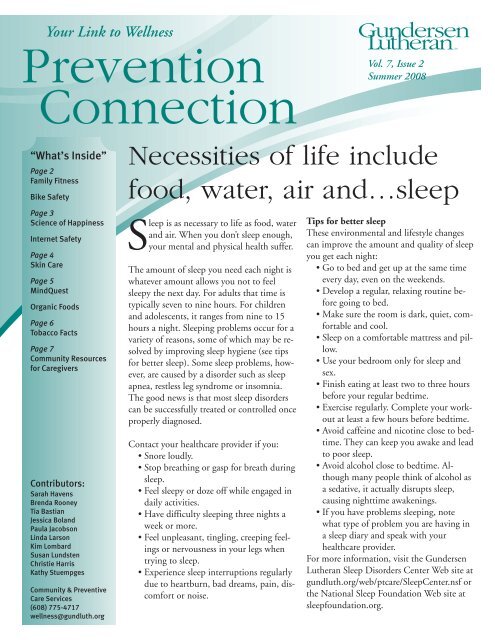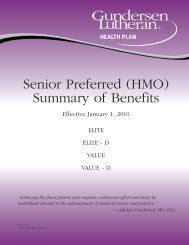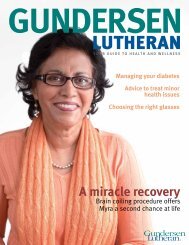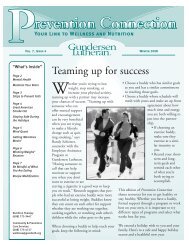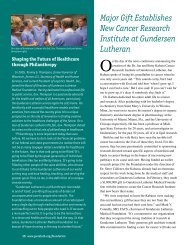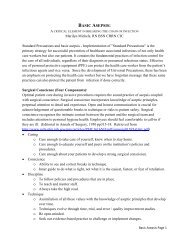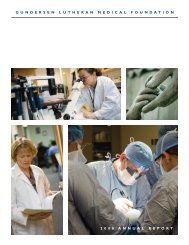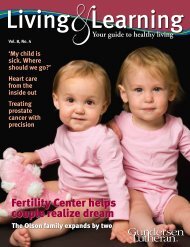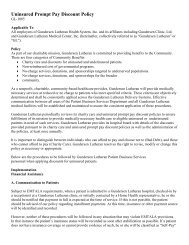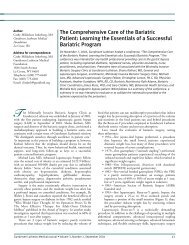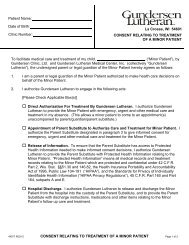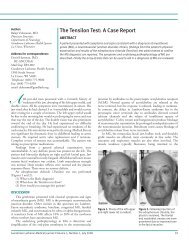Prevention Connection - Gundersen Health System
Prevention Connection - Gundersen Health System
Prevention Connection - Gundersen Health System
You also want an ePaper? Increase the reach of your titles
YUMPU automatically turns print PDFs into web optimized ePapers that Google loves.
Your Link to Wellness<br />
<strong>Prevention</strong><br />
<strong>Connection</strong><br />
Vol. 7, Issue 2<br />
Summer 2008<br />
“What’s Inside”<br />
Page 2<br />
Family Fitness<br />
Bike Safety<br />
Page 3<br />
Science of Happiness<br />
Internet Safety<br />
Page 4<br />
Skin Care<br />
Page 5<br />
MindQuest<br />
Organic Foods<br />
Page 6<br />
Tobacco Facts<br />
Page 7<br />
Community Resources<br />
for Caregivers<br />
Contributors:<br />
Sarah Havens<br />
Brenda Rooney<br />
Tia Bastian<br />
Jessica Boland<br />
Paula Jacobson<br />
Linda Larson<br />
Kim Lombard<br />
Susan Lundsten<br />
Christie Harris<br />
Kathy Stuempges<br />
Community & Preventive<br />
Care Services<br />
(608) 775-4717<br />
wellness@gundluth.org<br />
Necessities of life include<br />
food, water, air and…sleep<br />
Sleep is as necessary to life as food, water<br />
and air. When you don’t sleep enough,<br />
your mental and physical health suffer.<br />
The amount of sleep you need each night is<br />
whatever amount allows you not to feel<br />
sleepy the next day. For adults that time is<br />
typically seven to nine hours. For children<br />
and adolescents, it ranges from nine to 15<br />
hours a night. Sleeping problems occur for a<br />
variety of reasons, some of which may be resolved<br />
by improving sleep hygiene (see tips<br />
for better sleep). Some sleep problems, however,<br />
are caused by a disorder such as sleep<br />
apnea, restless leg syndrome or insomnia.<br />
The good news is that most sleep disorders<br />
can be successfully treated or controlled once<br />
properly diagnosed.<br />
Contact your healthcare provider if you:<br />
• Snore loudly.<br />
• Stop breathing or gasp for breath during<br />
sleep.<br />
• Feel sleepy or doze off while engaged in<br />
daily activities.<br />
• Have difficulty sleeping three nights a<br />
week or more.<br />
• Feel unpleasant, tingling, creeping feelings<br />
or nervousness in your legs when<br />
trying to sleep.<br />
• Experience sleep interruptions regularly<br />
due to heartburn, bad dreams, pain, discomfort<br />
or noise.<br />
Tips for better sleep<br />
These environmental and lifestyle changes<br />
can improve the amount and quality of sleep<br />
you get each night:<br />
• Go to bed and get up at the same time<br />
every day, even on the weekends.<br />
• Develop a regular, relaxing routine before<br />
going to bed.<br />
• Make sure the room is dark, quiet, comfortable<br />
and cool.<br />
• Sleep on a comfortable mattress and pillow.<br />
• Use your bedroom only for sleep and<br />
sex.<br />
• Finish eating at least two to three hours<br />
before your regular bedtime.<br />
• Exercise regularly. Complete your workout<br />
at least a few hours before bedtime.<br />
• Avoid caffeine and nicotine close to bedtime.<br />
They can keep you awake and lead<br />
to poor sleep.<br />
• Avoid alcohol close to bedtime. Although<br />
many people think of alcohol as<br />
a sedative, it actually disrupts sleep,<br />
causing nighttime awakenings.<br />
• If you have problems sleeping, note<br />
what type of problem you are having in<br />
a sleep diary and speak with your<br />
healthcare provider.<br />
For more information, visit the <strong>Gundersen</strong><br />
Lutheran Sleep Disorders Center Web site at<br />
gundluth.org/web/ptcare/SleepCenter.nsf or<br />
the National Sleep Foundation Web site at<br />
sleepfoundation.org.
Make fitness a priority for the whole family<br />
Children need at least 60 minutes of activity every<br />
day. They should also engage their muscles in a<br />
strengthening way twice a week by playing on the<br />
jungle gym, doing gymnastics or doing push-ups or pullups.<br />
Active kids enjoy the benefits of healthy bones and muscle<br />
joints. They build endurance and muscle strength. Exercise<br />
gives kids energy and helps promote healthy<br />
self-esteem. It also helps them to maintain a healthy<br />
weight. Some studies indicate that when kids are physically<br />
active they are more alert and attentive, helping<br />
them to better concentrate at school.<br />
Sixty minutes a day may seem like a lot to ask of your<br />
children, but as a parent, you can orchestrate activities to<br />
help everyone participate while having fun as a family. Go<br />
for family bike rides, take a trip to the local beach and go<br />
swimming, hike in the woods or go to the local high<br />
school and participate in Saturday morning basketball.<br />
of exercise? Start by choosing not to use the word exercise.<br />
Instead, suggest that you have fun and play. Even adults<br />
tend to be more excited about exercise if they know that<br />
they’ll have fun while doing something active. Parents are<br />
especially important role models for their children when<br />
it comes to being physically active.<br />
<strong>Gundersen</strong> Lutheran offers a fun physical activity program<br />
called Shoe Crew. Families or individuals may participate<br />
in this incentive-based program for a minimal<br />
charge. Members of the program keep track of the number<br />
of minutes they exercise and then turn in their time<br />
to win incentives. Shoe Crew also offers challenges that<br />
members can choose to join throughout the year. In these<br />
12-week challenges, members track their minutes of exercise,<br />
with a goal of 30 minutes of activity per day. All<br />
members who reach that goal are eligible to win a grand<br />
prize. The next Shoe Crew challenge will begin in May.<br />
To learn more about Shoe Crew programs, call (608)<br />
775-6861.<br />
What do you do when your kids absolutely hate the idea<br />
Practice bicycle safety to make riding more enjoyable<br />
Biking has been a popular pastime for people of all<br />
ages since the 1800s. There are many benefits to<br />
bicycling such as improved physical health and enhanced<br />
quality of life, as well as economic benefits for<br />
those who choose to ride their bikes instead of driving.<br />
Although biking is fun, if appropriate safety measures are<br />
not taken, serious injury and even death can occur. According<br />
to the Centers for Disease Control and <strong>Prevention</strong><br />
(CDC), more than 500,000 people in the U.S. are<br />
treated in emergency departments and more than 700<br />
people die as a result of bicycle-related injuries each year.<br />
Children are at particularly high risk for bicycle-related<br />
injuries. In 2001, children 15 years and younger accounted<br />
for 59 percent of all bicycle-related injuries seen<br />
in U.S. emergency departments.<br />
The single most effective safety device available to prevent<br />
serious injury and death from bicycle crashes is a helmet.<br />
Children are more likely to wear helmets if they see their<br />
parents wearing them. Children learn from their parents<br />
and will mimic their behavior. Also remember that bicycles<br />
share the roads with motor vehicles, so it is important<br />
to follow traffic laws.<br />
Tips to prevent injuries while biking:<br />
• Always wear a helmet that meets Consumer Product<br />
Safety Commission standards.<br />
• A correctly fitted helmet should be level. It should<br />
not rock forward and backward or side to side. Helmet<br />
straps must be buckled snug, not too tight or too<br />
loose.<br />
• Learn the rules of the road and obey all traffic laws.<br />
• Ride on the right side of the road with the traffic, not<br />
against traffic.<br />
• Use appropriate hand signals.<br />
• Respect traffic signals, stop at all stop signs and stop<br />
lights, stop and look both ways before going into a<br />
street.<br />
2
Science discovers what makes us happy<br />
There’s an ancient tale of happiness that appears in many cultures:<br />
Once there was a prince who was terribly unhappy. The king dispatched<br />
messengers to find the shirt of a happy man, as his advisors<br />
told him the shirt was the only cure for his son’s unhappiness. The messengers finally<br />
found a poor farmer who was supremely content. Alas, the happy man<br />
owned no shirt.<br />
Researchers know what doesn’t make us happy: once income provides our<br />
basic needs, additional money does not increase satisfaction, nor does intelligence,<br />
prestige or sunny weather. People grow used to new climates,<br />
higher salaries and better cars. Since 1960, real income has doubled; we’re<br />
twice as likely to own cars, air conditioners and clothes dryers. Yet our divorce<br />
rate has doubled and the incidence of teen suicide has tripled.<br />
Scientists also know what works: strong marriages, family ties and friendships<br />
predict happiness. Good self-esteem and spirituality do, too. Hope is<br />
crucial, as is the feeling that life has meaning.<br />
Happy people may be more likely to have all these characteristics at the<br />
start. Researchers think happiness is influenced by an inborn predisposition<br />
toward qualities that help or hinder happiness, such as optimism or<br />
shyness. Personality does not fluctuate much over an average life span.<br />
People have happiness set points. There is some wiggle room on either side<br />
of the set point, so we must do things that make us happy every day.<br />
You can raise your level of happiness by working on three components:<br />
1. Get more pleasure out of life by savoring sensory experiences such as<br />
the warmth of the sun or the sweet taste of a strawberry.<br />
2. Become more engaged in what you do.<br />
3. Find ways of making your life feel more meaningful.<br />
Other suggestions for a more satisfying life:<br />
• Count your blessings.<br />
• Practice acts of kindness.<br />
• Savor life’s joy.<br />
• Thank a mentor.<br />
• Learn to forgive.<br />
• Invest time and energy in friends and family.<br />
• Take care of your body.<br />
• Develop strategies for coping with stress and hardships.<br />
Internet usage<br />
guidelines protect<br />
children<br />
While access to the Internet<br />
exposes children to different<br />
cultures and ways<br />
of life and opens a world of possibilities,<br />
it can also expose children to<br />
many dangers.<br />
Be involved in your child’s online activities:<br />
• Set rules for your child’s Internet<br />
use.<br />
• Talk to your child about the<br />
dangers of the Internet.<br />
• Spend time online together.<br />
Teach your child appropriate behavior.<br />
• Find out what online protection<br />
your child’s school, after-school<br />
program, and friends have—or<br />
any other place where your child<br />
might use the computer.<br />
• Take advantage of parent-control<br />
options provided by your<br />
Internet service provider (ISP).<br />
• Share an e-mail account with<br />
your child so you can monitor<br />
messages.<br />
• If your child visits chat rooms,<br />
create or approve his or her<br />
screen name.<br />
• Monitor credit card and phone<br />
bills for unfamiliar account<br />
charges.<br />
• Do not allow your child to give<br />
out any personal information.<br />
• Do not allow your child to meet<br />
someone they have only talked<br />
with online.<br />
• Forward copies of obscene messages<br />
to your Internet service<br />
provider (ISP).<br />
3
Take care of the skin you’re in<br />
Your skin is your largest organ. It protects your<br />
body from damage, infection and the environment.<br />
The myths of skin care are endless. These myth<br />
busters will clear things up:<br />
Myth: Acne and black heads are caused by dirt.<br />
Truth: Acne develops when sebum, dead skin cells<br />
and bacteria clog your pores. The dark color of<br />
blackheads isn’t dirt. It’s the coloring of the dead<br />
cells at the top of the clogged pores.<br />
Myth: The best way to deal with oily skin is to dry<br />
it out.<br />
Truth: There is a difference between oiliness and<br />
hydration. The goal is to keep your skin balanced<br />
and clean, not to dry it out. If you dry skin too<br />
much, it can become irritated and scaly while remaining<br />
oily. If you have oily skin, use an oil-free<br />
moisturizer.<br />
Myth: Chocolate makes your skin break out.<br />
Truth: The food you eat does not cause acne. Your<br />
skin does not absorb the oils and grease from food.<br />
Acne is caused when a gland sheds cells that stick<br />
together, plug the gland and form a pimple in the<br />
skin, which bacteria feeds on.<br />
Myth: A close shave reduces the risk of ingrown<br />
hairs.<br />
Truth: The biggest cause of ingrown hairs is shaving<br />
too closely. Hair stubs cut too close are likely to<br />
become trapped inside the hair follicle where, instead<br />
of growing straight out, they grow inwards or<br />
sideways. To prevent ingrown hairs, a single-blade<br />
razor may be a better option that the twin or triple<br />
blades. Don’t pull the skin taut or press the razor<br />
hard against the skin while shaving and remember<br />
not to shave against the grain.<br />
Myth: Tanning will clear up blemishes.<br />
Truth: Tanning is likely to do more harm than<br />
good. While a suntan or sunburn may camouflage<br />
acne, it may also set you up to become one of five<br />
Americans who get skin cancer. Tanning can actually<br />
turn acne’s red spots a permanent shade of<br />
brown and cause scarring.<br />
Myth: A good base tan will protect me from sunburn.<br />
Truth: While your body’s melanin helps prevent<br />
sun damage, a good base tan is not the same as having<br />
ample natural melanin in the skin. Seven minutes<br />
in a tanning bed can equal four hours of sun<br />
exposure and up to 20 times the ultraviolet (UV)<br />
light exposure provided by the sun. Many people<br />
who’ve never been scorched still get skin cancer.<br />
Myth: Men don’t have as many skin problems as<br />
women.<br />
Truth: Men wrinkle as much as women do. They<br />
get skin conditions such as acne and blackheads,<br />
just like women. Men also have additional concerns<br />
related to facial hair. Men tend to spend less money<br />
on skin care products, however, and don’t use sunscreen<br />
or protect their skin enough.<br />
Tips for healthy skin<br />
1. Stop smoking or never start. Smoking causes<br />
premature aging, yellowing and drying of the<br />
skin.<br />
2. Drink plenty of water.<br />
3. Use sunscreens to protect yourself from<br />
harmful UV radiation. Don’t forget your<br />
lips.<br />
4. Eat a healthy, well-balanced diet with plenty<br />
of fruits and vegetables.<br />
5. Gently cleanse your skin one to two times a<br />
day, but don’t overdo it. Don’t scrub or exfoliate<br />
too hard or too often.<br />
6. Keep skin moist at all times. Moisturizers<br />
work best when applied while the skin is still<br />
damp.<br />
7. Lack of sleep can lead to formation of wrinkles<br />
below your eyes. The best way to prevent<br />
wrinkles is to get a good night’s sleep on a<br />
regular basis.<br />
8. Exercise is good for your whole body, including<br />
your skin. It can help improve skin tone<br />
and maintain elasticity.<br />
9. Know your skin type. Not every skin care<br />
product suits everyone.<br />
10. If you have skin problems such as itching,<br />
dryness, suspicious moles or rashes, consult<br />
your physician.<br />
4
MindQuest<br />
Fill in the missing numbers so every row, column<br />
and quadrant contains the number 1<br />
through 9.<br />
Target Time: 12 minutes<br />
7 3<br />
6 8<br />
1<br />
9<br />
1 5<br />
2 7<br />
8 3<br />
7 4 5 1<br />
1 2<br />
9 4<br />
6<br />
4 7<br />
6<br />
8 5<br />
1 3<br />
What does organic really mean?<br />
Organically grown foods are foods that are grown or<br />
processed without the use of synthetic fertilizers or pesticides.<br />
The standards for growing and labeling organic<br />
food may vary depending upon the certifying organization<br />
or agency.<br />
The National Organic Program (NOP) provides consumers<br />
with information on how organic foods are produced,<br />
processed and certified to be consistent with<br />
national organic standards. These standards apply to raw,<br />
fresh products and processed foods that contain organic<br />
ingredients.<br />
One hundred percent organic products must contain (not<br />
counting water and salt) only organically produced ingredients.<br />
Organic products must consist of at least 95 percent organically<br />
produced ingredients (not counting water and<br />
salt). They cannot contain added sulfites. They may contain<br />
up to 5 percent non-organically produced ingredients<br />
and/or other substances.<br />
Products made with organic ingredients are processed<br />
products that contain at least 70 percent organic ingredients.<br />
They cannot contain added sulfites. (Exceptions<br />
may apply for wine.) They may contain up to 30 percent<br />
non-organically produced ingredients and/or other substances.<br />
Here are some facts to consider when making purchases:<br />
• Organically grown foods may cost up to 50-100 percent<br />
more than conventionally grown foods because<br />
there is a smaller supply of organics there is an increased<br />
labor cost in producing organic foods.<br />
• Both organic and conventional foods provide nutritious<br />
sustenance when selected as part of a well-balanced<br />
diet.<br />
• Organic foods are not free of synthetic pesticide<br />
residues but probably contain smaller amounts of the<br />
residues than conventionally grown foods.<br />
If you have specific medical questions about organically<br />
grown foods, consult your medical provider or nutritionist.<br />
Sources: U.S. Department of Agriculture, UpToDate.com<br />
5
Quit tobacco for you and those you love<br />
Tobacco-related deaths continue to be the largest<br />
preventable cause of death in the United States.<br />
Quitting smoking is the best thing you can do to<br />
improve and protect your health.<br />
Did you know…<br />
• Cigarette smoke contains more than 4,800 chemicals,<br />
69 of which are known to cause cancer.<br />
• Smoking is directly responsible for about 90 percent<br />
of lung cancer deaths and about 80-90 percent of<br />
chronic obstructive pulmonary disease (COPD)<br />
deaths, such as those caused by emphysema and<br />
chronic bronchitis.<br />
• Smoking is a major factor in coronary heart disease<br />
and stroke.<br />
• Smoking is linked to slow healing of wounds, infertility<br />
and peptic ulcer disease.<br />
• Smoking can cause pneumonia.<br />
• Smoking in pregnancy accounts for an estimated 20-<br />
30 percent of low-birth weight babies, up to 14 percent<br />
of premature deliveries and about 10 percent of<br />
infant deaths.<br />
• Smoking by parents is also associated with a wide<br />
range of adverse effects in children, including:<br />
– making asthma worse<br />
– increased frequency of colds and ear infections<br />
– increase in sudden infant death syndrome<br />
(SIDS)<br />
• Secondhand smoke causes:<br />
– irritation of the eyes, nose and throat<br />
– irritation of lungs leading to coughing, excessive<br />
phlegm and chest discomfort<br />
– an estimated 22,700-69,600 deaths per year<br />
from heart disease in adult non-smokers<br />
– about 3,000 deaths each year from lung cancer<br />
in non-smokers<br />
– lower respiratory tract infections in children,<br />
often resulting in hospitalization<br />
Resources to help you quit or to help you support<br />
someone who is quitting<br />
Tobacco quit lines – A quit coach can provide you with<br />
information and resources to help you quit for good. The<br />
service is free and confidential. You may be able to tap<br />
into free product resources as well.<br />
In Wisconsin (800) QUIT NOW; (800) 784-8669<br />
In Minnesota (888) 354-PLAN; (888) 354-7526<br />
In Iowa (866) U CAN TRY; (866) 822-6879 or<br />
(800) QUIT NOW; (800) 784-8669<br />
Medical provider – Talk with your doctor about quitting<br />
smoking. Your doctor can help you set up a quit plan and<br />
prescribe medications to help you with the quitting<br />
process. There is no magic pill, but products are available<br />
to make quitting more manageable.<br />
<strong>Gundersen</strong> Lutheran resources – If you need help finding<br />
a medical provider, call Community and Preventive<br />
Care Services at (608) 775-5442 or (800) 362-9567, ext<br />
55442. We can help you through the process.<br />
Source: American Lung Association<br />
Many people quit smoking to protect their health or have<br />
a chance for better health. Improved health may be your<br />
motivation, along with many other important outcomes.<br />
Discover the reason that matters to you, and you’ve taken<br />
the first step.<br />
6
Community resources available to assist<br />
older adults and caregivers<br />
Are you an older adult who needs assistance with<br />
food stamps, transportation or benefits counseling?<br />
Do you have an aging parent, family member or<br />
friend who needs home-delivered meals, supportive home<br />
care or respite services? Many community resources are not<br />
used because people are unaware that they exist.<br />
Resources and contact information available to older<br />
adults, family members and caregivers:<br />
The Aging and Disability Resource Center of<br />
La Crosse County<br />
Services include disability and long-term care-related services<br />
and living arrangements, health and behavioral health,<br />
adult protective services, employment and training for people<br />
with disabilities, transportation, home maintenance,<br />
nutrition and family care, food stamps and social security.<br />
Information is available 24 hours a day.<br />
(800) 500-3910<br />
La Crosse County Aging Program<br />
Services include housing, transportation, social programs,<br />
support groups, recreational and educational opportunities,<br />
supportive home care, healthcare, benefit issues, nutritional<br />
services and Senior Edition newsletter.<br />
(608) 785-9710<br />
Vernon County Aging Unit<br />
Services include senior meal options, home-delivered meal<br />
program, nutrition check screening, transportation program,<br />
trained benefit specialists to discuss legal issues and<br />
provide assistance with government benefit programs, caregiver<br />
and respite services, health prevention educational<br />
topics such as managing chronic conditions, falls prevention,<br />
medication management and exercise programs.<br />
(608) 637-5201<br />
Crawford County Senior Resources<br />
Services include senior dining meal options, home-delivered<br />
meals, and registered dietician consultations; trained<br />
benefit specialists to discuss private or government benefits<br />
such as Social Security and food stamps; transportation<br />
services; caregiver services and support; and Crawford<br />
County Communiqué.<br />
(608) 326-0235<br />
Aging and Disability Resource Center of Trempealeau<br />
County<br />
Services include confidential, professional consultations;<br />
assistance planning and advocacy; connections to homecare,<br />
meals, transportation, respite/caregiver support and<br />
housing.<br />
(800) 273-2001<br />
Monroe County Senior Services<br />
Services include meal sites, home-delivered meals and food<br />
stamps; benefit specialists available to answer questions<br />
pertaining to social security, Medicare, homestead tax<br />
credit, medical claims and elder abuse; transportation services;<br />
and monthly recreational outings.<br />
(608) 269-8690<br />
Great Rivers 2-1-1<br />
An information and referral crisis line available 24 hours a<br />
day. From information on support groups and temporary<br />
housing to resources for dealing with depression and victims<br />
of sexual abuse, information is available regarding a<br />
variety issues. Dial 2-1-1 or toll free in Wis., Minn., and<br />
Iowa, (800) 362-8255; TTY (866) 884-3620.<br />
<strong>Gundersen</strong> Lutheran Telephone Nurse Advisors<br />
This service is staffed by registered nurses and is available<br />
24 hours a day to answer any health-related questions you<br />
may have. They can direct you to the right kind of care<br />
you need for your health issues. Call: (608) 775-4454 or<br />
toll free (800) 858-1050.<br />
Independent Living Resources<br />
Services include providing information and resources to individuals<br />
with disabilities including housing options, benefits<br />
counseling, accessibility of private and public areas,<br />
personal care services, independent living skills training,<br />
and advocacy.<br />
(888) 474-5745<br />
7
1900 South Avenue<br />
La Crosse, WI 54601<br />
www.gundluth.org<br />
Non-Profit<br />
Organization<br />
U.S. Postage<br />
P A I D<br />
La Crosse, WI<br />
Permit No. 395<br />
Did You Know?<br />
When you don’t sleep enough your mental and physical<br />
health suffer.<br />
Each year in the U.S., more than 500,000 people are<br />
treated in emergency departments and more than 700<br />
people die as a result of bicycle-related injuries.<br />
Your skin is your largest organ.<br />
Organic products must consist of at least 95 percent organically<br />
produced ingredients (not counting water and<br />
salt). They cannot contain added sulfites, but they may<br />
contain up to 5 percent non-organically produced ingredients<br />
and/or other substances.<br />
For more information on these topics, see the articles inside<br />
this newsletter.<br />
8<br />
Answers to MindQuest 7 2 3<br />
6 8 9<br />
1 4 5<br />
8 3 1<br />
9 7 4<br />
2 5 6<br />
5 1 8<br />
3 6 2<br />
4 9 7<br />
8 9 4<br />
7 1 5<br />
2 3 6<br />
4 5 7<br />
6 2 3<br />
1 8 9<br />
3 7 2<br />
9 4 1<br />
5 6 8<br />
6 5 1<br />
2 3 4<br />
8 7 9<br />
9 6 2<br />
5 1 8<br />
3 4 7<br />
4 9 6<br />
7 8 5<br />
1 2 3
<strong>Prevention</strong> <strong>Connection</strong><br />
Wellness<br />
Calendar<br />
May<br />
3-9 Bike to Work Week<br />
• May 3, Kick-off event, Myrick Park Gun Shelter<br />
• May 3-4, Bike to Worship<br />
• May 5-8, Bike the neighborhoods, La Crosse and Onalaska<br />
• May 9, Closing celebration, Cameron Park<br />
3 West Salem Bike Rodeo<br />
St. Clare <strong>Health</strong> Mission Run/Walk<br />
5 Journey to Freedom in La Crosse begins – 16 weeks,<br />
beginning at noon and 5:30 p.m. in <strong>Gundersen</strong><br />
Lutheran’s Mooney <strong>Health</strong> Resource Center. Anyone<br />
who wants to quit smoking cigarettes, cigars or pipe, or<br />
stop using chewing tobacco is welcome at this clinic.<br />
The cost is $130 with a $40 rebate for completion of<br />
program and required attendance. Pre-registration is required.<br />
Contact (608) 775-5442.<br />
Unless otherwise noted, call Community & Preventive<br />
Care Services at (608) 775-4717 for more information.<br />
Or check out our web site at www.gundluth.org/wellness<br />
or e-mail: wellness@gundluth.org.<br />
June<br />
2 Winning Weighs begins – 12 weeks beginning at<br />
5:30 p.m. at <strong>Gundersen</strong> Lutheran, La Crosse. Contact<br />
(608) 775-4147.<br />
14 Flag Day<br />
Minds in Motion Bicycle Tour<br />
15 Happy Father’s Day<br />
17 Getting Older, Living Better nutrition program –<br />
9:30 a.m. to noon, Southside Neighborhood Center,<br />
1300 S. 6th St, La Crosse. Pre-registration is required.<br />
Contact (608) 775-4717.<br />
21 Summer begins<br />
July<br />
4 Independence Day<br />
6 Journey to Freedom in Onalaska begins – 16 weeks,<br />
beginning at noon in <strong>Gundersen</strong> Lutheran’s Support<br />
Services Building, Onalaska. Same description, price<br />
and contact number as La Crosse, above.<br />
10 March of Dimes Walk<br />
12 Shoe Crew Challenge begins<br />
11 Minutes in Motion activity challenge ends<br />
Happy Mother’s Day<br />
15 Minutes in Motion final minutes due<br />
16 Asthma Walk<br />
21 Minutes in Motion celebration, 4:30-6 p.m., Riverside<br />
Park, La Crosse<br />
26 Memorial Day<br />
continued...
More program information<br />
Journey to Freedom Support Group is a free Tobacco Relapse<br />
<strong>Prevention</strong> and Support Group that meets the first Wednesday<br />
of each month, noon and 5:30 p.m., Mooney <strong>Health</strong> Resource<br />
Library, <strong>Gundersen</strong> Lutheran, La Crosse. Contact Community<br />
& Preventive Care Services at (608) 775-5442.<br />
Massage Therapy is available at <strong>Gundersen</strong> Lutheran on the<br />
La Crosse Campus. Contact Community & Preventive Care<br />
Services at (608) 775-4717.<br />
Shoe Crew Activity Program can help you stay physically active.<br />
It is designed to encourage you to exercise regularly and<br />
make healthy choices by providing incentives to keep you on the<br />
road to wellness. Contact Christie Harris at<br />
(608) 775-6861.<br />
Housing Options for Older Adults is a free brochure available<br />
by calling (608) 775-4717. As we age, many of us will have to<br />
make decisions regarding where we will live. This brochure offers<br />
information to help make those choices easier.<br />
Transportation Options for the Tri-State Area is a free<br />
brochure available by calling (608) 775-4717. This brochure<br />
provides information to help with your transportation needs.<br />
Swing Into Shape is a specialized exercise program that is medically<br />
sound and safe, proven to help improve health and wellbeing,<br />
and has specially trained instructors. It is for those<br />
recovering from an illness or injury, just starting an exercise program<br />
or experiencing age-related changes. To order a video, contact<br />
Community & Preventive Care Services at (608) 775-4717.<br />
Videos are also on sale at the <strong>Gundersen</strong> Lutheran Gift Shop.<br />
Free Cardiac Education Classes are held on Mondays at<br />
7:45 a.m., 10 a.m., and 1:45 p.m. in the patient education<br />
room on the sixth floor of the Hospital. For more information,<br />
call (608) 775-2955.<br />
Winning Weighs ® Teammates Support Group is held Mondays<br />
at 12 p.m. in Onalaska and Thursdays at 12 p.m. & 5 p.m.<br />
in La Crosse. For more information, call 775-3447.<br />
Senior Preferred - Medicare Advantage Plan information,<br />
contact <strong>Gundersen</strong> Lutheran <strong>Health</strong> Plan at 775-8777 or<br />
(800) 370-9718.<br />
Acupuncture is available at the <strong>Gundersen</strong> Lutheran - Onalaska<br />
and Viroqua Clinics. For more information contact the Onalaska<br />
Clinic at (608) 775-1395 or the Viroqua Clinic at (608)<br />
637-3195.<br />
Unless otherwise noted, contact Community & Preventive<br />
Care Services at (608) 775-4717 for more information.<br />
Check out <strong>Gundersen</strong> Lutheran’s Web site:<br />
gundluth.org/wellness or e-mail: wellness@gundluth.org<br />
For more information on Support Groups in our area, contact<br />
Great Rivers 211 or go to www.gundluth.org then choose<br />
“Events, Classes & Support Groups.”<br />
• Adult Survivors of Sexual Abuse Support Group<br />
• Al-Anon or Alateen Meetings<br />
• AphasiaSupport Group<br />
• Brain Injury Support Group<br />
• Breast Friends: Breast Cancer Support Group<br />
• Co-dependent Group Sessions<br />
• Epilepsy Support and Education Group<br />
• Greater La Crosse Area Stroke Club<br />
• Heart Failure Education Classes<br />
• Jon Sierzant Brain Tumor Support Group<br />
• Laparoscopic Gastric Bypass support group<br />
• Laparoscopic Gastric Bypass One Year - Plus support group<br />
• Journey to Freedom Nicotine Relapse <strong>Prevention</strong> & Support<br />
Group<br />
• Multiple Sclerosis Self-Help Group<br />
• Ostomy Association<br />
• Parkinsons Support Group<br />
• Pregnancy Loss Support Group<br />
• Prostate Cancer Support Group<br />
• Wisconsin Chapter for Ileitis and Colitis


